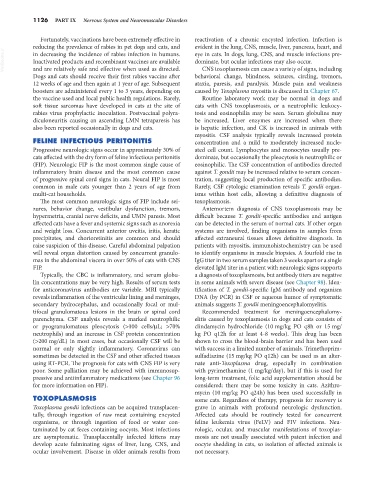Page 1154 - Small Animal Internal Medicine, 6th Edition
P. 1154
1126 PART IX Nervous System and Neuromuscular Disorders
Fortunately, vaccinations have been extremely effective in reactivation of a chronic encysted infection. Infection is
reducing the prevalence of rabies in pet dogs and cats, and evident in the lung, CNS, muscle, liver, pancreas, heart, and
VetBooks.ir in decreasing the incidence of rabies infection in humans. eye in cats. In dogs, lung, CNS, and muscle infections pre-
dominate, but ocular infections may also occur.
Inactivated products and recombinant vaccines are available
CNS toxoplasmosis can cause a variety of signs, including
and are relatively safe and effective when used as directed.
Dogs and cats should receive their first rabies vaccine after behavioral change, blindness, seizures, circling, tremors,
12 weeks of age and then again at 1 year of age. Subsequent ataxia, paresis, and paralysis. Muscle pain and weakness
boosters are administered every 1 to 3 years, depending on caused by Toxoplasma myositis is discussed in Chapter 67.
the vaccine used and local public health regulations. Rarely, Routine laboratory work may be normal in dogs and
soft tissue sarcomas have developed in cats at the site of cats with CNS toxoplasmosis, or a neutrophilic leukocy-
rabies virus prophylactic inoculation. Postvaccinal polyra- tosis and eosinophilia may be seen. Serum globulins may
diculoneuritis causing an ascending LMN tetraparesis has be increased. Liver enzymes are increased when there
also been reported occasionally in dogs and cats. is hepatic infection, and CK is increased in animals with
myositis. CSF analysis typically reveals increased protein
FELINE INFECTIOUS PERITONITIS concentration and a mild to moderately increased nucle-
Progressive neurologic signs occur in approximately 30% of ated cell count. Lymphocytes and monocytes usually pre-
cats affected with the dry form of feline infectious peritonitis dominate, but occasionally the pleocytosis is neutrophilic or
(FIP). Neurologic FIP is the most common single cause of eosinophilic. The CSF concentration of antibodies directed
inflammatory brain disease and the most common cause against T. gondii may be increased relative to serum concen-
of progressive spinal cord signs in cats. Neural FIP is most tration, suggesting local production of specific antibodies.
common in male cats younger than 2 years of age from Rarely, CSF cytologic examination reveals T. gondii organ-
multi-cat households. isms within host cells, allowing a definitive diagnosis of
The most common neurologic signs of FIP include sei- toxoplasmosis.
zures, behavior change, vestibular dysfunction, tremors, Antemortem diagnosis of CNS toxoplasmosis may be
hypermetria, cranial nerve deficits, and UMN paresis. Most difficult because T. gondii-specific antibodies and antigen
affected cats have a fever and systemic signs such as anorexia can be detected in the serum of normal cats. If other organ
and weight loss. Concurrent anterior uveitis, iritis, keratic systems are involved, finding organisms in samples from
precipitates, and chorioretinitis are common and should affected extraneural tissues allows definitive diagnosis. In
raise suspicion of this disease. Careful abdominal palpation patients with myositis, immunohistochemistry can be used
will reveal organ distortion caused by concurrent granulo- to identify organisms in muscle biopsies. A fourfold rise in
mas in the abdominal viscera in over 50% of cats with CNS IgG titer in two serum samples taken 3 weeks apart or a single
FIP. elevated IgM titer in a patient with neurologic signs supports
Typically, the CBC is inflammatory, and serum globu- a diagnosis of toxoplasmosis, but antibody titers are negative
lin concentrations may be very high. Results of serum tests in some animals with severe disease (see Chapter 98). Iden-
for anticoronavirus antibodies are variable. MRI typically tification of T. gondii-specific IgM antibody and organism
reveals inflammation of the ventricular lining and meninges, DNA (by PCR) in CSF or aqueous humor of symptomatic
secondary hydrocephalus, and occasionally focal or mul- animals suggests T. gondii meningoencephalomyelitis.
tifocal granulomatous lesions in the brain or spinal cord Recommended treatment for meningoencephalomy-
parenchyma. CSF analysis reveals a marked neutrophilic elitis caused by toxoplasmosis in dogs and cats consists of
or pyogranulomatous pleocytosis (>100 cells/µL; >70% clindamycin hydrochloride (10 mg/kg PO q8h or 15 mg/
neutrophils) and an increase in CSF protein concentration kg PO q12h for at least 4-8 weeks). This drug has been
(>200 mg/dL) in most cases, but occasionally CSF will be shown to cross the blood-brain barrier and has been used
normal or only slightly inflammatory. Coronavirus can with success in a limited number of animals. Trimethoprim-
sometimes be detected in the CSF and other affected tissues sulfadiazine (15 mg/kg PO q12h) can be used as an alter-
using RT-PCR. The prognosis for cats with CNS FIP is very nate anti-Toxoplasma drug, especially in combination
poor. Some palliation may be achieved with immunosup- with pyrimethamine (1 mg/kg/day), but if this is used for
pressive and antiinflammatory medications (see Chapter 96 long-term treatment, folic acid supplementation should be
for more information on FIP). considered; there may be some toxicity in cats. Azithro-
mycin (10 mg/kg PO q24h) has been used successfully in
TOXOPLASMOSIS some cats. Regardless of therapy, prognosis for recovery is
Toxoplasma gondii infections can be acquired transplacen- grave in animals with profound neurologic dysfunction.
tally, through ingestion of raw meat containing encysted Affected cats should be routinely tested for concurrent
organisms, or through ingestion of food or water con- feline leukemia virus (FeLV) and FIV infections. Neu-
taminated by cat feces containing oocysts. Most infections rologic, ocular, and muscular manifestations of toxoplas-
are asymptomatic. Transplacentally infected kittens may mosis are not usually associated with patent infection and
develop acute fulminating signs of liver, lung, CNS, and oocyte shedding in cats, so isolation of affected animals is
ocular involvement. Disease in older animals results from not necessary.

